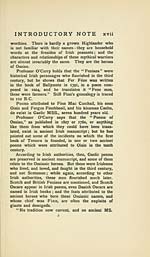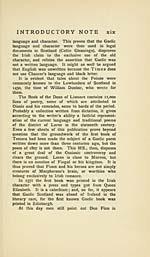Ossian Collection > Poems of Ossian
(22)
Download files
Complete book:
Individual page:
Thumbnail gallery: Grid view | List view

xviii INTRODUCTORY NOTE
of which I have heard, makes any mention of the
kingdom of Morven or its King Fingal. I believe
that the kingdom is an invention of the compounder
of Ossian's poems, whoever he may have been."
As for the poet, to whom nearly all the old
poetry in the Highlands is now attributed, his date
and origin are as uncertain as his father's. If he
was Finn's son he could not have survived to con-
verse with St Patrick, nor have lived with a fairy
lady in the land of youth ; he is in Gaelic popular
tradition and old Gaelic lore the counterpart of
Thomas the Rymour, who was a living man in 1280,
and yet went to fairyland, and has the credit of
being a prophet, a magician, and a poet— the author
of Sir Tristrem.
The date of Fionn and his family may be the
third century ; but unless there were many who bore
the same names, the exploits of a series of men and
the fabulous deeds of mythological characters must
have gathered about the names of this single family.
I am still inclined to believe that these heroes of
popular romance were ancient Celtic gods.
The only Gaelic traditional reference to a people
with a name like that of the Picts is an occasional
but very rare mention of Piocaich as a kind of
men.
The Celts had swords, and spears, and shields,
and mail, like the traditional Feinne, and in a poem
the banner of Fionn is described.
In a charter of lands in Morayshire, the words
"Tubar na Fein" occur. This is explained to mean
"The well of the great or kempis men," which
proves that the name of the Feinne was even then
associated with the topography of the eastern High-
lands. (Celtic Gleanings, MacLauchlan.)
In 1408 a charter of lands in Islay was written in
the usual form of Latin charters, but in the Gaelic
of which I have heard, makes any mention of the
kingdom of Morven or its King Fingal. I believe
that the kingdom is an invention of the compounder
of Ossian's poems, whoever he may have been."
As for the poet, to whom nearly all the old
poetry in the Highlands is now attributed, his date
and origin are as uncertain as his father's. If he
was Finn's son he could not have survived to con-
verse with St Patrick, nor have lived with a fairy
lady in the land of youth ; he is in Gaelic popular
tradition and old Gaelic lore the counterpart of
Thomas the Rymour, who was a living man in 1280,
and yet went to fairyland, and has the credit of
being a prophet, a magician, and a poet— the author
of Sir Tristrem.
The date of Fionn and his family may be the
third century ; but unless there were many who bore
the same names, the exploits of a series of men and
the fabulous deeds of mythological characters must
have gathered about the names of this single family.
I am still inclined to believe that these heroes of
popular romance were ancient Celtic gods.
The only Gaelic traditional reference to a people
with a name like that of the Picts is an occasional
but very rare mention of Piocaich as a kind of
men.
The Celts had swords, and spears, and shields,
and mail, like the traditional Feinne, and in a poem
the banner of Fionn is described.
In a charter of lands in Morayshire, the words
"Tubar na Fein" occur. This is explained to mean
"The well of the great or kempis men," which
proves that the name of the Feinne was even then
associated with the topography of the eastern High-
lands. (Celtic Gleanings, MacLauchlan.)
In 1408 a charter of lands in Islay was written in
the usual form of Latin charters, but in the Gaelic
Set display mode to: Large image | Transcription
Images and transcriptions on this page, including medium image downloads, may be used under the Creative Commons Attribution 4.0 International Licence unless otherwise stated. ![]()
| Early Gaelic Book Collections > Ossian Collection > Poems of Ossian > (22) |
|---|
| Permanent URL | https://digital.nls.uk/82630775 |
|---|
| Description | Selected books from the Ossian Collection of 327 volumes, originally assembled by J. Norman Methven of Perth. Different editions and translations of James MacPherson's epic poem 'Ossian', some with a map of the 'Kingdom of Connor'. Also secondary material relating to Ossianic poetry and the Ossian controversy. |
|---|
| Description | Selected items from five 'Special and Named Printed Collections'. Includes books in Gaelic and other Celtic languages, works about the Gaels, their languages, literature, culture and history. |
|---|

